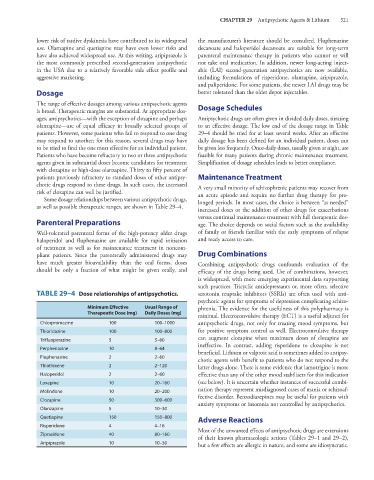Page 535 - Basic _ Clinical Pharmacology ( PDFDrive )
P. 535
CHAPTER 29 Antipsychotic Agents & Lithium 521
lower risk of tardive dyskinesia have contributed to its widespread the manufacturer’s literature should be consulted. Fluphenazine
use. Olanzapine and quetiapine may have even lower risks and decanoate and haloperidol decanoate are suitable for long-term
have also achieved widespread use. At this writing, aripiprazole is parenteral maintenance therapy in patients who cannot or will
the most commonly prescribed second-generation antipsychotic not take oral medication. In addition, newer long-acting inject-
in the USA due to a relatively favorable side effect profile and able (LAI) second-generation antipsychotics are now available,
aggressive marketing. including formulations of risperidone, olanzapine, aripiprazole,
and paliperidone. For some patients, the newer LAI drugs may be
Dosage better tolerated than the older depot injectables.
The range of effective dosages among various antipsychotic agents Dosage Schedules
is broad. Therapeutic margins are substantial. At appropriate dos-
ages, antipsychotics—with the exception of clozapine and perhaps Antipsychotic drugs are often given in divided daily doses, titrating
olanzapine—are of equal efficacy in broadly selected groups of to an effective dosage. The low end of the dosage range in Table
patients. However, some patients who fail to respond to one drug 29–4 should be tried for at least several weeks. After an effective
may respond to another; for this reason, several drugs may have daily dosage has been defined for an individual patient, doses can
to be tried to find the one most effective for an individual patient. be given less frequently. Once-daily doses, usually given at night, are
Patients who have become refractory to two or three antipsychotic feasible for many patients during chronic maintenance treatment.
agents given in substantial doses become candidates for treatment Simplification of dosage schedules leads to better compliance.
with clozapine or high-dose olanzapine. Thirty to fifty percent of
patients previously refractory to standard doses of other antipsy- Maintenance Treatment
chotic drugs respond to these drugs. In such cases, the increased A very small minority of schizophrenic patients may recover from
risk of clozapine can well be justified. an acute episode and require no further drug therapy for pro-
Some dosage relationships between various antipsychotic drugs, longed periods. In most cases, the choice is between “as needed”
as well as possible therapeutic ranges, are shown in Table 29–4.
increased doses or the addition of other drugs for exacerbations
versus continual maintenance treatment with full therapeutic dos-
Parenteral Preparations age. The choice depends on social factors such as the availability
Well-tolerated parenteral forms of the high-potency older drugs of family or friends familiar with the early symptoms of relapse
haloperidol and fluphenazine are available for rapid initiation and ready access to care.
of treatment as well as for maintenance treatment in noncom-
pliant patients. Since the parenterally administered drugs may Drug Combinations
have much greater bioavailability than the oral forms, doses Combining antipsychotic drugs confounds evaluation of the
should be only a fraction of what might be given orally, and efficacy of the drugs being used. Use of combinations, however,
is widespread, with more emerging experimental data supporting
such practices. Tricyclic antidepressants or, more often, selective
TABLE 29–4 Dose relationships of antipsychotics. serotonin reuptake inhibitors (SSRIs) are often used with anti-
psychotic agents for symptoms of depression complicating schizo-
Minimum Effective Usual Range of phrenia. The evidence for the usefulness of this polypharmacy is
Therapeutic Dose (mg) Daily Doses (mg)
minimal. Electroconvulsive therapy (ECT) is a useful adjunct for
Chlorpromazine 100 100–1000 antipsychotic drugs, not only for treating mood symptoms, but
Thioridazine 100 100–800 for positive symptom control as well. Electroconvulsive therapy
Trifluoperazine 5 5–60 can augment clozapine when maximum doses of clozapine are
ineffective. In contrast, adding risperidone to clozapine is not
Perphenazine 10 8–64
beneficial. Lithium or valproic acid is sometimes added to antipsy-
Fluphenazine 2 2–60
chotic agents with benefit to patients who do not respond to the
Thiothixene 2 2–120 latter drugs alone. There is some evidence that lamotrigine is more
Haloperidol 2 2–60 effective than any of the other mood stabilizers for this indication
Loxapine 10 20–160 (see below). It is uncertain whether instances of successful combi-
Molindone 10 20–200 nation therapy represent misdiagnosed cases of mania or schizoaf-
fective disorder. Benzodiazepines may be useful for patients with
Clozapine 50 300–600
anxiety symptoms or insomnia not controlled by antipsychotics.
Olanzapine 5 10–30
Quetiapine 150 150–800 Adverse Reactions
Risperidone 4 4–16
Most of the unwanted effects of antipsychotic drugs are extensions
Ziprasidone 40 80–160
of their known pharmacologic actions (Tables 29–1 and 29–2),
Aripiprazole 10 10–30 but a few effects are allergic in nature, and some are idiosyncratic.

